Open Air Wrap In Tussock
Our Open Air Wrap is a familiar favorite, but it undergoes a splendid reinvention when paired with our gorgeous new Tussock!
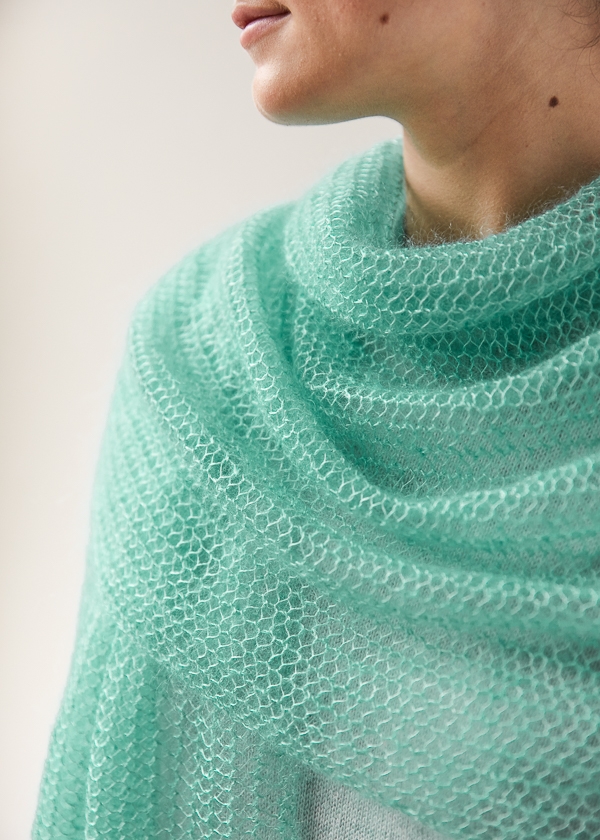
This wrap may look as diaphanous as floating mist, but don’t be fooled…It’s really a halo of soft and cozy warmth. Tussock is 60% super fine kid mohair and 40% silk, a blend that insulates with a feather-light touch and a lovely luster.
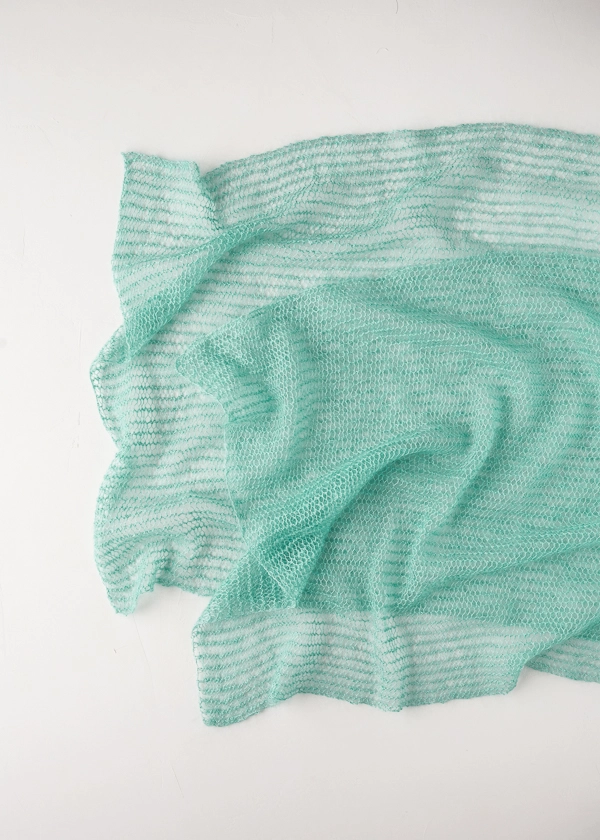
You’ll quickly master the Open Air Wrap’s super-simple one-row repeat of open lacework. Yup, just repeat one row and watch it grow into a fabric that’s part fine filigree, part fluffy down.
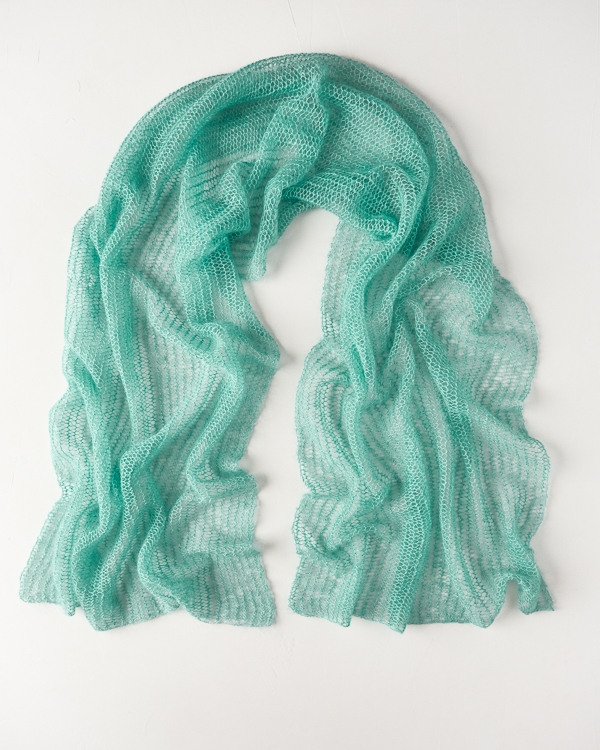
Choose from 17 beautiful colors of Tussock. We used three skeins of Bright Verdigris, a crisp reflection of the icy season, but you may want to pick a few of your favorites, because this version of our Open Air Wrap is especially fun to share… A real wow-you-made-this? kind of gift!
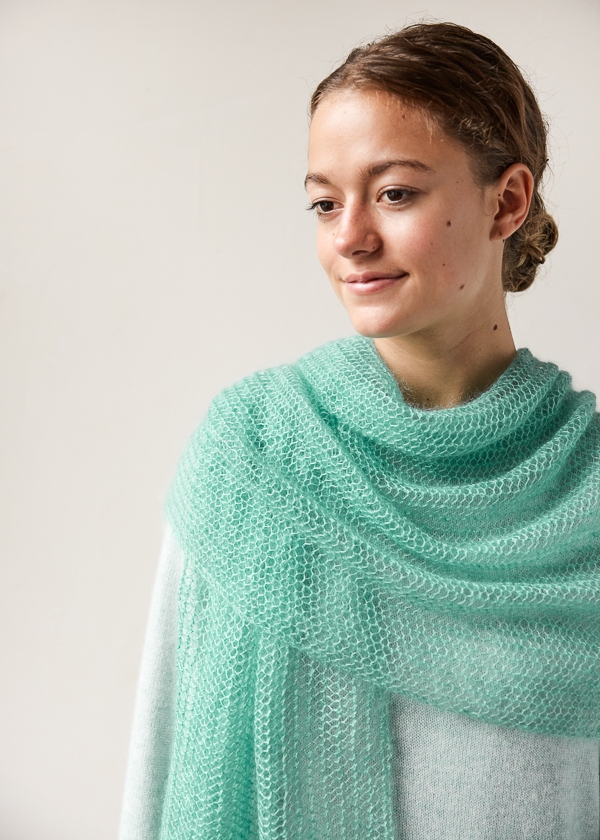
Designed by Purl Soho designer, Whitney Van Nes.
Share your progress and connect with the community by tagging your pics with #PurlSoho, #PurlSohoBusyHands, #PurlSohoOpenAirWrap, and #PurlSohoTussock. We can’t wait to see what you make!
Materials
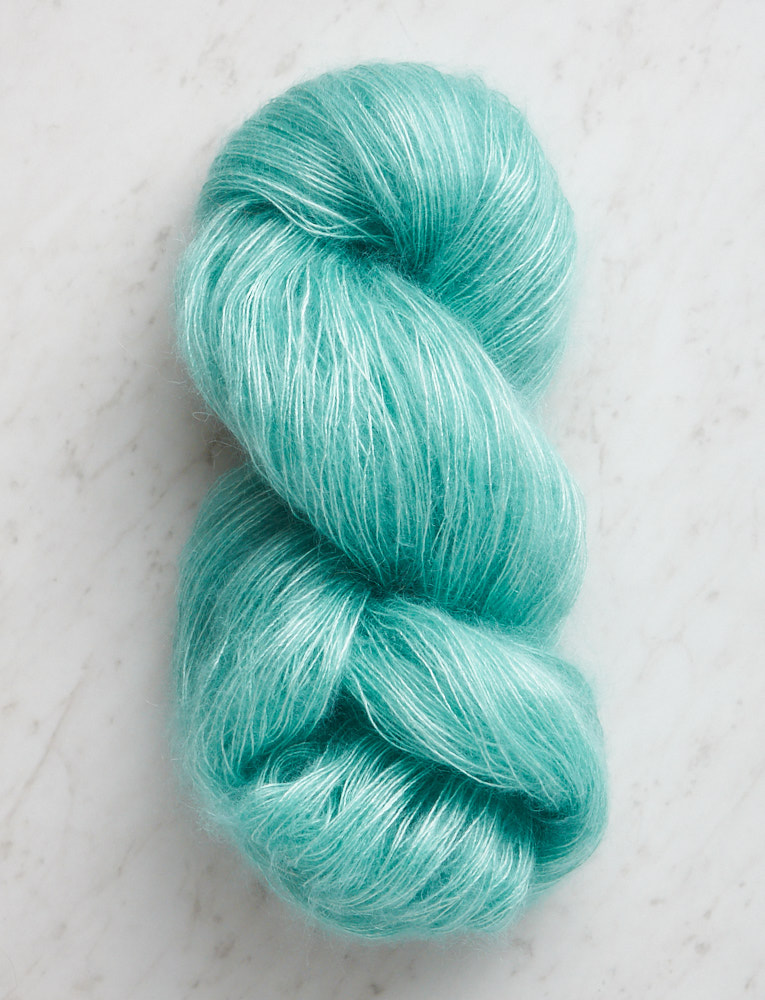
- 3 skeins of Purl Soho’s Tussock, 60% super fine kid mohair and 40% silk. Each skein is 328 yards/ 25 grams; approximately 984 yards required. We used Bright Verdigris.
- US 4 (3.5 mm), straight or circular needles
Gauge
21 stitches = 4 inches unblocked
17 ½ stitches = 4 inches blocked
Size
Dimensions, Unblocked: 18½ inches wide x 72 inches long
Finished Dimensions, Blocked: 22½ inches wide x 75 inches long
Pattern
For the free pattern, please visit our original Open Air Wrap story.
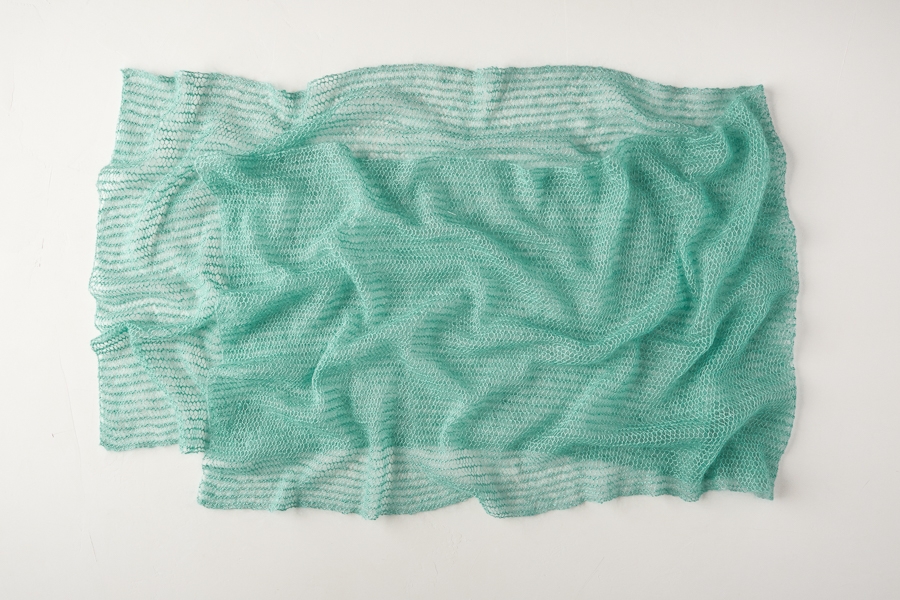

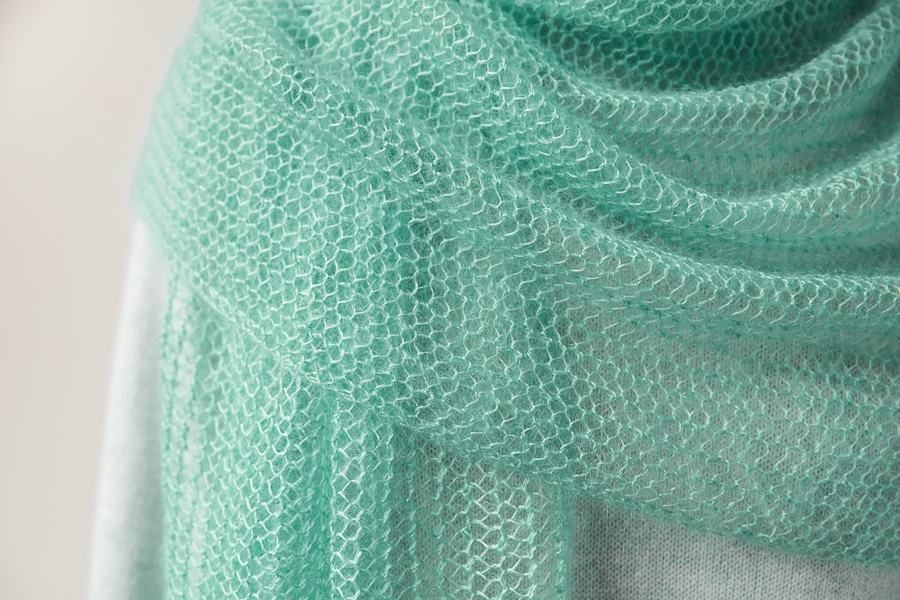
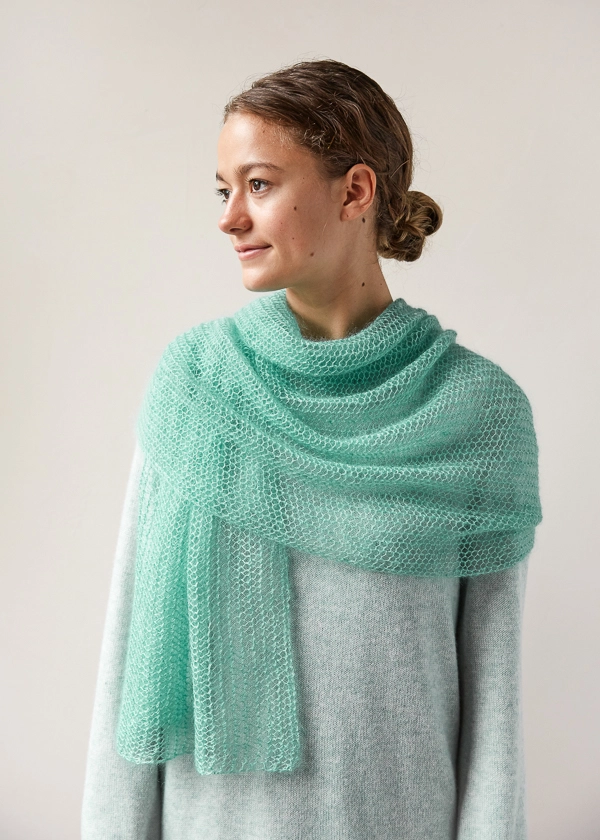
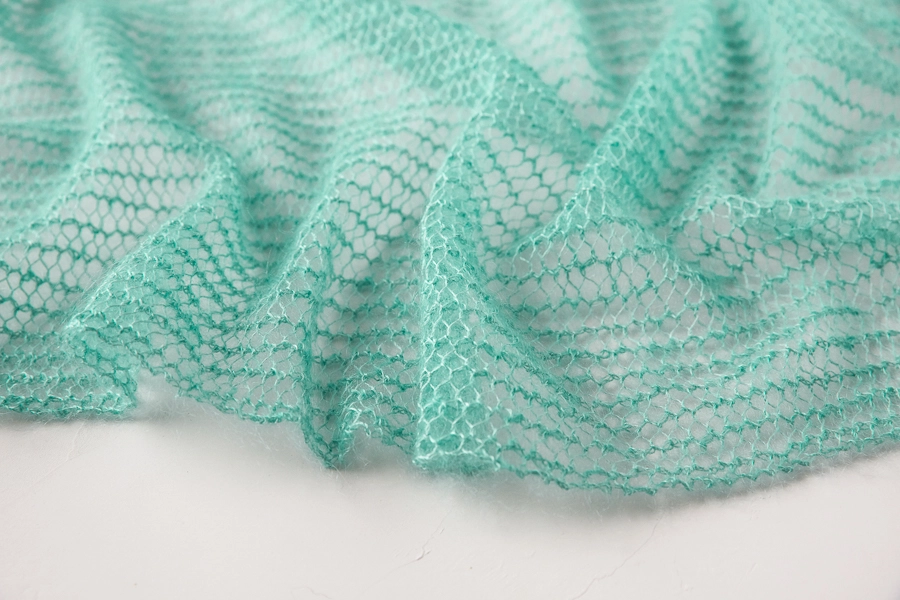
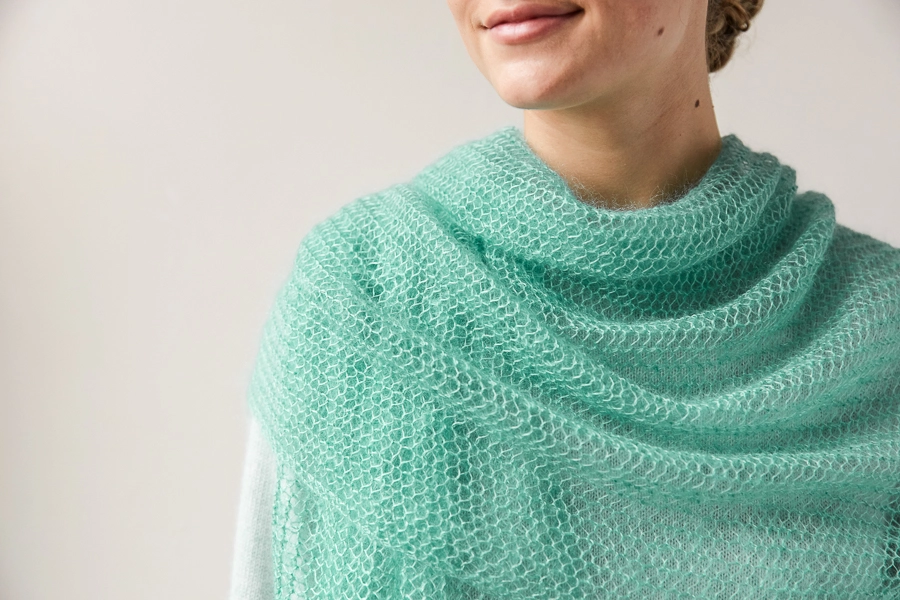


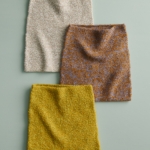
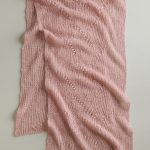

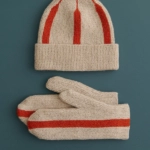


Hello,
Can I use Cat Tail Silk yarn for this pattern? How many skeins will I need and what needle size should I use?
Thank you.
Grace
Hi Grace,
You could absolutely use Cattail Silk for this pattern! Two skeins should be plenty for this project, and I’d recommend using a US4 needle; you can pretty much stick to the same instructions listed in the pattern using Tussock, as they are both fingering weight yarns!
I hope this helps, and Happy Knitting!
Warmly,
Kelsey
This is such a lovely pattern. I’m wanting to make matching wraps for my sister and her daughters. Would you have recommendations on how to size down for children? We are talking about 12 and 5 years old.
Hi Jacqui,
Thanks for reaching out! That is such a sweet gift! Since this pattern is pattern works over an even number of stitches you can easily customize the width of the wrap by simply adjusting how many stitches you cast on. For a 12 year old I would suggest about 10″ wide (unblocked) and about 14″ wide (blocked), so if your gauge is consistent with the pattern I would recommend casting on 64 stitches! For the 5 year old I think a scarf size would be a bit more appropriate, appropriately 6″ wide unblocked and 10″ wide blocked, so you would cast on 34 stitches for that! You can think knit in the stitch pattern until you reach your desired length for each piece.
I hope this helps and please let em know if you have any more questions!
Warmly,
Gianna
Wo finde ich das Muster um den Schal zu stricken?
Hi Heike,
Thanks for reaching out! The pattern for this wrap is located on the page of the original design. We provide a link to this page under the PATTERN heading, and you can also click right here. Hope this helps!
All the best,
Lili
Can I use Brume for this pattern? If so, how many skeins and what size needles?
Thanks so much,
Stephanie
Hi Stephanie,
Thanks for reaching out. You can absolutely use Brume for this pattern! I’d recommend using size US 6 needles in this case, and you’ll need 4 skeins. Hope this helps!
All the best,
Lili
Ich freue mich jeden Tag auf ihre newsletter. Schade das sie nicht in deutscher Sprache gibt.
Can I use cashmere?
Also I’d like to make a cowl using this pattern. How many stitches do I need to cast on?
Hi Virginia,
Thanks for reaching out! You could certainly use cashmere for this pattern! I would suggest using a fingering weight yarn as we did for the pattern, but I do suggest working a gauge swatch prior to beginning to ensure you are consistent with the pattern! From there you can calculate your cast on depending on how many stitches per inch you would like and the width you would like for your cowl. Just be sure to cast on an even number of stitches!
I hope this helps!
Gianna
i have 6 skeins of coorie and thought to make this with it. i wonder what needle size and # of cast on sts you would recommend..thanks so much, diana
Hi Diana,
Thanks for writing in! I would suggest using a US 5 or 6 needle with Coorie for this pattern, but I would recommend starting off by working a gauge swatch and seeing which needle size you prefer with the stitch pattern! From there you can calculate your stitches per inch to determine how many stitches to cast on. For more information on gauge, you can check out our wonderful tutorial, All About Gauge!
I hope this helps, happy knitting!
Gianna
How would you adjust the pattern to make a cowl? I could just make it shorter and sew it together but with something so delicate a seam might not look good.
Hi Mommo,
Thanks for writing in! That would be pretty simple if you knit the cowl flat and then seam it up. If you do that, I would suggest using a whip stitch to keep the seam delicate!
I hope this helps, happy knitting!
Gianna
What exactly is the point of using Long Tail cast-on? It just seems complicated and unnecessary. Wouldn’t a regular cast on do just as well? Thank you for the info.
Hi Lola,
Thanks for reaching out! We recommend using a basic Long Tail Cast On since it is very easy and beginner-friendly, it is also a quick way to cast on larger amounts of stitches! Alternatively, you could use a Cable Cast On, but it will take a bit longer to cast on 98 stitches. I have linked to both our tutorials for step by step instructions (highlighted in pink)
I hope this helps, happy knitting!
Gianna
What medium weight yarns can this be made with.
I prefer for cooler weather. Maybe on a size 7 or 8 needles.
Thank You.
Hi Phyllis,
Thanks for writing in! If you would like to use a US 7 or 8 needle I would recommend using a sport weight yarn. A few beautiful options would be Brume or Good Wool! I suggest starting off by working a gauge swatch to determine how many stitches you will want to cast on.
I hope this helps, happy knitting!
Gianna
Please help. I am stuck in a loop and cannot see the pattern for the open air wrap in Tussock. I just bought yarn to make two of these and every time I try to open the pattern it sends me to the open air story. When I open the story it’s another link to open the story. Again, stuck in a loop. Can I please be directed to the pattern or attach a PDF etc.? Much appreciated since I already purchased two patterns worth of yarn.
Thanks,
Lisa
Hi Lisa,
Thanks for reaching out! The Story link should take you to the original pattern page (for your convenience I have also added it here) from there if you scroll down past the Materials section you will find the Notes section and then the Pattern section! The original is knit in a different yarn, but we used the exact same pattern for the Tussock version.
I hope this helps, happy knitting!
Gianna
thank heavens for comments. i am allergic to mohair! i have some one special i actually met a few times. this pattern is a dream. thank you form my heart.
I have a “2” weight yarn…..874 yards – could I use this? I was thinking I could make it half as wide, if I had to reduce the size.
Thanks for your time.
Hi Gail,
Thanks for reaching out. The great part about this pattern is that it’s easily adaptable to any weight yarn! The only thing you’d need to modify is the number of stitches you cast on. To figure out your cast-on number, you will want to first knit a gauge swatch in pattern. Once you know how many stitches you are getting per inch, you can multiply that number by the width that you would like and cast on the nearest even number. Then, you can follow the pattern as written! I hope this helps.
All the best,
Lili
Hi,
Can this shawl be knitted as a triangular shawl?
Hi Cheryl,
Thanks for reaching out with your question!
As of right now we only have the rectangular version of this pattern written, but if you are good as reworking patterns, I can’t see why this pattern couldn’t be knit as a triangular shawl! The repeat is worked over 2 stitches, and you’ll need 2 additional stitches for the first and last stitch of the row.
You might also be interested in looking at some of our other triangular shawls, like the Asymmetrical Wrap, or the Striped Triangle Garter Wrap for inspiration!
I hope this helps!
All the best,
Carly
Thank you Gianna for your reply in March about changing the wrap to a cowl. Life intervened and I didn’t get to look at replies until just now.
Hello,
With my old lady eyes, I am struggling with this pattern using Tussock. I’m wondering whether I could use 2 strands (possibly using a coordinating color) and size 6 needle as in the elementary wrap in tussock. If so, how many stitches should I cast on?
Thank you!
Hi Diana,
Thanks for reaching out! You can absolutely use Tussock held double with another yarn and larger needles for this project! The gauge of your project will be different from the original sample, so I would recommend knitting a gauge swatch before casting on your project. Once we know how many stitches per inch you are getting, you can multiply that by 22.5″ for the width to get the cast-on number! Here’s our tutorial called All About Gauge that you might find helpful for this project.
Please let us know if you have any questions!
All the best,
Carly
Any trick to knitting the first row? I’m on my fourth try. The yarn is so fine it’s like knitting with spider silk. I’m having a terrible time. I hope I figure it out; the yarn is beautiful and I want to finish this project. Thanks.
Hello,
Thanks for reaching out to us with your question! I can totally understand how frustrating it can be to keep starting your project over, especially with such a fine yarn!
I would recommend knitting a small swatch before casting on for your project. This can help you get familiar with the stitches, and how the yarn-overs line up with the p2tog stitches. The cast on for this pattern should be an even number, so you can cast on 10 stitches for a swatch and knit in pattern.
If you are finding that you don’t like working in tussock, we also have a version of this wrap knit in Linen Quill here!
I hope this helps, and please let us know if you have any other questions!
All the best,
Carly
Thanks. I’ll keep trying.
After the seventh try to start this project I didn’t give up but cast onto a larger needle and worked it with the recommended size 4. Solved my problems.
For Tussock yarn (mohair/ silk) how do you recommend winding it?
Thanks.
Hi Lisa!
Thank you for your question! Tussock is a very fine and delicate yarn, which means it helps to take some extra care while winding so that it does not tangle. I recommend winding this yarn a bit slower than usual, and stuffing a piece of paper or the yarn label itself around the middle of the cake so that it does not collapse in on itself. Because of the mohair fiber content, the strands will tend to stick together, so taking care to separate any connected strands as you wind will help, too!
If you happen to find your yarn in a tangle, another trick we recommend is putting the yarn in the freezer for a few hours before attempting to untangle! This helps freeze the fibers in place so that they can glide more smoothly when untangling any knots.
I hope this helps you get started on your wrap!
All the best,
Margaret
Well, I thought I had my problems solved. But no. Not at all. This beautiful yarn is impossible for me to work with. I tried the first row probably 8-10 times. I thought casting on with a larger needle solved my problems. It didn’t. The yarn is so fine and the stitches so small I find it hard to make a stitch. I think I need more pointed needles to even have a chance. When you purl the two stitch together, which stitch is first to go on your working needle: the slipped stitch or the purled one? I’m thinking it should be the purl then the slipped stitch. Last time I was trying the first row, the slipped stitch was first and the purl second. It just wasn’t working. And I seem to lose or gain stitches: once I had 65, then 60 (I cast on 64). You’d think I was a novice but I’ve been knitting for 50 years. I never give up on anything but I’m getting close. Help.
Hi Mommo,
We are so sorry to hear that you’re still having trouble with both this pattern and the yarn itself!
Sharper needles could definitely help, but I wanted to mention using wooden needles, as opposed to metal, to grip the strands more easily. If using Tussock alone, it also helps to put the yarn in the freezer for a few hours to relax the fibers and make the yarn less sticky. This is especially useful when you have to undo any work to fix a mistake.
As for the p2tog, you are correct in that the p2tog should be worked by inserting your needle a p2tog and a yarn over (in that order). We have a great tutorial for how the yarn overs work together with the p2togs on this page as well!
I apologize again for the frustrating experience you have had, especially after multiple attempts and so much knitting experience under your belt! If you’re still not comfortable picking this project back up, we recommend reaching out to us via email at customerservice@purlsoho.com to see if we can offer you more personalized options there!
All the best,
Margaret
Thank you. I’ll keep giving it a go. I ignored it for a few days and started my Nine Note Scarf. So much easier to knit! But I’ll tackle it again soon. Thanks for your advice. I’ve had stranger things in my freezer.
You are very welcome, and please feel free to get in touch with us if you have any other questions when you pick this project up again!
All the best,
Margaret
Like several other knitters I have struggled with this pattern and Tussock more times than I would want to admit. I have finally combined the Tussock with another lightweight yarn and am liking the results, however I am not able to understand how to fix a dropped stitch down two rows or so. Can you offer any advice?
Thanks.
leslie
Hi Leslie,
Thanks for reaching out. Tussock is definitely tricky to knit with on its own! I would recommend putting in a lifeline a few rows down (below your dropped stitch) and rip back to that point. With the lifeline in, your stitches will be safe! Then, you can start reknitting that section with the correct amount of stitches. Hope this helps!
All the best,
Lili
Hello! This is such a lovely pattern! Would a merino fingering weight work?
Hi Tali,
Thanks for reaching out. Yes, this pattern is very adaptable, and nearly any relatively-thin yarn will work great! I’d just recommend knitting up a gauge swatch beforehand, since you may need to adjust the cast-on number so that the wrap comes to the correct width.
To figure out your cast-on number, you will want to first knit a gauge swatch in pattern and block the swatch. Once you know how many stitches you are getting per inch, you can multiply that number by the width that you would like and cast on the nearest even number. Then you can follow the pattern as written!
All the best,
Lili
Hi, is there a crochet pattern similar to the open air wrap? Thanks!
Hi Hande,
Thank you for writing in! While we don’t have an exact sister pattern to this wrap, you could use our Ripples Scarf as a starting point using our Tussock yarn and the same hook size written into the pattern!
I hope this helps but please let us know if you have any other questions!
Happy making,
Gavriella
Hi, I’ve been wanting to make this in Brume but I don’t see it anymore. Is it no longer available? And can you suggest something similar to brume (I thin for me, tussock is difficult to work with)?
Thanks!
Hi Robin,
Thank you for writing in! We have unfortunately discontinued Brume but holding a single strand of fingering weight yarn like Quartz or Linen Quill with Tussock could make the mohair more comfortable and manageable to work with as you are knitting. The mohair in our tussock base is what’s going to give your project that halo effect you see here! You could also hold two strands of Tussock together to get a similar weight to Brume! I hope this helps but please let me know if you have any other questions!
Warmly,
Gavriella